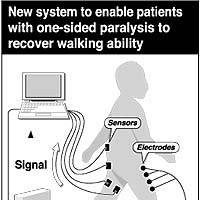A Hokkaido University research team has developed an automated system that uses electric stimulation to allow patients suffering from one-sided paralysis to recover their walking ability.
Earlier electric stimulus devices failed to provide smooth walking movements because patients were required to turn them on and off themselves.
The new walking aid marks a breakthrough as the process of sending the signals has been automated, according to the group, led by Shanghai's Yu Wenwei, an assistant researcher in Hokkaido University's engineering department.
The new system employs sensors that are attached to the hip, back and thigh of the normal leg to record electric signals generated inside the muscles when walking, the team said.
The signals are then processed by computer, converted into electric stimulation and sent to the nerve cells of the paralyzed leg via scores of electrodes implanted in the leg to make the muscles move.
The user, whose electrodes are attached to a personal computer, can walk around the computer. The group plans to make the system ready for practical use within five years by developing implantable devices.
"Yu's system worked very well on our patients," said Hokkaido University professor Yukio Mano, a rehabilitation expert who collaborated on the project. "They moved their legs smoothly."
Mano is seeking the brisk development of implantable devices that will make the entire system portable.
That day seems not too far away, according to Yu.
"It will not be long before the new system becomes wireless," Yu said, noting that wires can cause skin infections. The technology to place power sources inside the body has already been developed, he added.
Yu also said that his team will seek to develop a system to help quadriplegics move their leg and arm muscles.


















With your current subscription plan you can comment on stories. However, before writing your first comment, please create a display name in the Profile section of your subscriber account page.